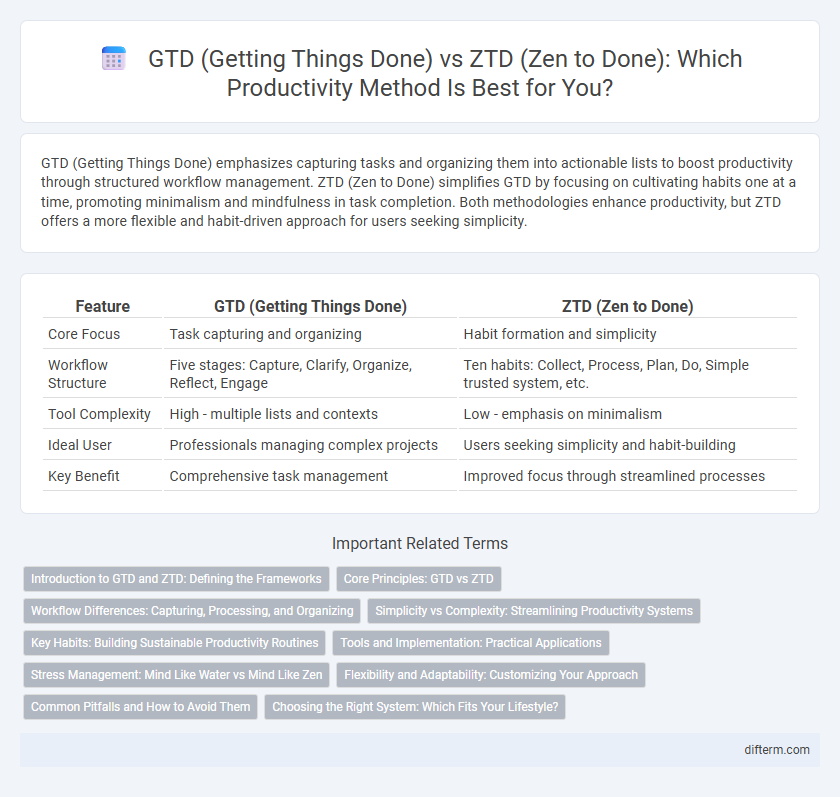GTD (Getting Things Done) emphasizes capturing tasks and organizing them into actionable lists to boost productivity through structured workflow management. ZTD (Zen to Done) simplifies GTD by focusing on cultivating habits one at a time, promoting minimalism and mindfulness in task completion. Both methodologies enhance productivity, but ZTD offers a more flexible and habit-driven approach for users seeking simplicity.
Table of Comparison
| Feature | GTD (Getting Things Done) | ZTD (Zen to Done) |
|---|---|---|
| Core Focus | Task capturing and organizing | Habit formation and simplicity |
| Workflow Structure | Five stages: Capture, Clarify, Organize, Reflect, Engage | Ten habits: Collect, Process, Plan, Do, Simple trusted system, etc. |
| Tool Complexity | High - multiple lists and contexts | Low - emphasis on minimalism |
| Ideal User | Professionals managing complex projects | Users seeking simplicity and habit-building |
| Key Benefit | Comprehensive task management | Improved focus through streamlined processes |
Introduction to GTD and ZTD: Defining the Frameworks
GTD (Getting Things Done) is a productivity framework developed by David Allen that emphasizes capturing all tasks and ideas into an external system to clear mental clutter and enhance focus. ZTD (Zen to Done), created by Leo Babauta, builds on GTD principles by simplifying and prioritizing habits to foster sustainable productivity through mindfulness and minimalism. Both frameworks guide task management but differ in approach, with GTD focusing on detailed processing and ZTD on habit formation and simplicity.
Core Principles: GTD vs ZTD
GTD (Getting Things Done) emphasizes capturing every task and breaking work into actionable steps to reduce mental clutter and enhance productivity, prioritizing workflow organization and task management. ZTD (Zen to Done) simplifies GTD by focusing on habit formation, limiting priorities, and streamlining workflows to foster focus and reduce overwhelm. Both methodologies center on improving productivity, but GTD prioritizes comprehensive task processing while ZTD emphasizes simplicity and sustainable habits.
Workflow Differences: Capturing, Processing, and Organizing
GTD relies on a comprehensive capturing system using inboxes to collect all tasks, followed by a rigorous processing phase to clarify next actions and outcomes. ZTD simplifies capturing by emphasizing habit formation and limiting processing to daily priorities, reducing cognitive overload. Organizing in GTD involves extensive contexts and projects lists, whereas ZTD advocates minimalistic systems focusing on simplicity and daily routines to enhance flow and focus.
Simplicity vs Complexity: Streamlining Productivity Systems
GTD (Getting Things Done) emphasizes a comprehensive, multi-step approach for managing tasks and projects, supporting users with detailed lists and review processes that can become complex over time. In contrast, ZTD (Zen to Done) prioritizes simplicity by integrating crucial GTD elements into a more straightforward and habit-driven system, reducing overwhelm and fostering consistent productivity. Streamlining productivity with ZTD helps maintain focus and clarity, making task management more accessible for users seeking less complexity.
Key Habits: Building Sustainable Productivity Routines
GTD (Getting Things Done) emphasizes capturing, clarifying, organizing, reflecting, and engaging to manage tasks efficiently, fostering a comprehensive productivity system focused on task management and workflow mastery. ZTD (Zen to Done) distills GTD principles into ten streamlined habits, prioritizing simplicity, focus, and consistent routine-building to cultivate sustainable productivity and reduce overwhelm. Both methodologies emphasize key habits like daily planning, setting priorities, and regular review, but ZTD's minimalist approach targets habit formation for long-term behavioral change in productivity routines.
Tools and Implementation: Practical Applications
GTD (Getting Things Done) emphasizes extensive tools like project lists, contexts, and next actions to capture and organize tasks, enabling detailed task management and prioritization. ZTD (Zen to Done) streamlines implementation by focusing on fewer tools such as a simplified to-do list and habit formation, promoting ease of adoption and consistent execution. Practical application of GTD suits users needing comprehensive structure, while ZTD appeals to those seeking minimalist, habit-driven productivity systems.
Stress Management: Mind Like Water vs Mind Like Zen
GTD emphasizes "Mind Like Water," a state of clear, calm readiness achieved by capturing and organizing tasks to reduce mental clutter and stress. ZTD builds on this by promoting "Mind Like Zen," which simplifies GTD principles into focused, mindful routines that cultivate tranquility and sustained productivity. Both methods aim to manage stress effectively, but ZTD integrates mindfulness practices to deepen mental clarity and emotional balance.
Flexibility and Adaptability: Customizing Your Approach
GTD (Getting Things Done) offers a comprehensive framework emphasizing detailed task organization, while ZTD (Zen to Done) promotes simplicity and habit-building for flexible implementation. ZTD allows users to adapt core principles to fit personal workflows, enhancing adaptability and reducing overwhelm. Customizing your productivity system using elements from both methods fosters a balanced approach tailored to individual needs and changing priorities.
Common Pitfalls and How to Avoid Them
Common pitfalls in GTD include overcomplication and inconsistent review habits, which can be mitigated by simplifying task lists and establishing daily or weekly review routines. ZTD encounters challenges in maintaining discipline and avoiding perfectionism; focusing on building one habit at a time and embracing incremental progress helps prevent overwhelm. Both methods benefit from customizing workflows to individual productivity rhythms and leveraging digital tools for task management and reminders.
Choosing the Right System: Which Fits Your Lifestyle?
GTD (Getting Things Done) excels in detailed task management and comprehensive organization, ideal for individuals who thrive on structure and extensive planning. ZTD (Zen to Done) emphasizes simplicity and habit formation, making it better suited for those seeking a minimalist approach with gradual productivity improvements. Selecting the right system depends on personal workflow preferences, with GTD favoring complexity and ZTD offering a streamlined, habit-driven method.
GTD (Getting Things Done) vs ZTD (Zen to Done) Infographic

 difterm.com
difterm.com